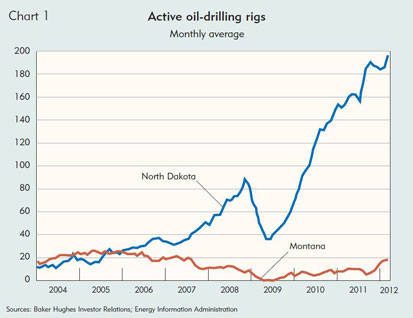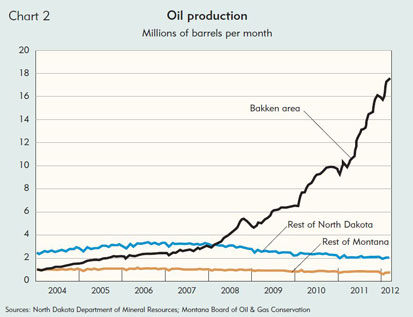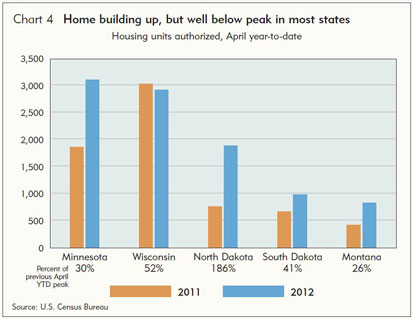According to the Minneapolis Fed’s forecasting model and results from recent surveys, the moderate economic recovery of the past few years will continue through 2013. The exception is North Dakota and areas servicing oil drilling, where strong economic growth is expected.
Employment levels will expand moderately, while unemployment rates will decrease somewhat, according to forecasting models. Some signs of improvement are noted in home building, while the services sector and tourism are expected to perform well. Meanwhile, a warm spring followed by plenty of rainfall has crops positioned for a strong harvest this fall.
North Dakota keeps booming
Oil-drilling operations in western North Dakota continue at a torrid pace (see Chart 1). In May, an average of 199 oil rigs were operating in North Dakota and 20 in Montana, almost all in the Bakken and related formations in western North Dakota and eastern Montana. In April, 17.5 million barrels of oil were produced in the Bakken area (see Chart 2). Last year in April, 9.8 million barrels were produced in this area. (See the Bakken page for more data.) North Dakota is now the second-largest oil-producing state in the country after Texas.
Combined with a strong agriculture sector and healthy economies in North Dakota’s three largest cities (Bismarck, Grand Forks and Fargo), payroll employment in the state grew by over 5 percent last year. According to the Minneapolis Fed’s forecasting models, employment growth will continue to expand in the state by over 5 percent in 2012 and 2013, while the unemployment rate will drop to 3 percent (See forecast.). Strong economic activity is anticipated in this area for some time to come.
Employment grows moderately; home building shows improvement
Despite the outsized performance in North Dakota, nonfarm employment in May across the Ninth District was up just 0.5 percent compared with a year ago and considerably slower than the national growth rate of 1.4 percent (see Chart 3). Strong employment growth in North Dakota, and moderate growth elsewhere in the district, was overwhelmed by a decrease in employment in Wisconsin. The strongest gains were reported in natural resources and mining (20 percent, mostly due to the oil patch), professional and business services (2.8 percent), education and health services (2.2 percent) and manufacturing (1.7 percent). Meanwhile, employment levels decreased in government (-1 percent) and leisure and hospitality (-3.7 percent).
After posting decreases over the past few years, construction employment increased 0.7 percent in May, which is good news for a troubled sector affected by housing activity. From 2006 to 2010, district housing units authorized decreased well over 50 percent, and construction employment decreased 24 percent in district states over the same period. While residential construction generally accounts for only about 10 percent to 15 percent of construction employment, during the downturn almost 20 percent of construction jobs lost were in residential construction.
Through the first four months of 2012, however, there are signs of improvement (though still well below peak home-building levels in the middle of the last decade). Housing units authorized more than doubled in North Dakota and Montana compared with a year earlier. Solid gains were also observed in Minnesota and South Dakota (see Chart 4).
There were other signs of housing recovery as well. For example, the Minnesota Association of Realtors reported that May home sales were up 11 percent from a year earlier and that home prices increased 10 percent.
Employment gains in manufacturing continued in a sector that has provided strength to the district economy during the recovery, a good share of it attributable to export growth, which increased by 10 percent last year (see related story). According to a survey by Creighton University (Omaha, Neb.), manufacturing activity posted solid growth during April and May in Minnesota and the Dakotas.
Going forward, the Minneapolis Fed’s forecasting models predict moderate gains in employment through 2013—with the exception of North Dakota, where employment will grow faster—and modest decreases in unemployment rates for district states.
Services and tourism show positive signs
The outlook for professional services firms is positive, according to a May survey by the Federal Reserve Bank of Minneapolis and the Minnesota Department of Employment and Economic Development. Over the next four quarters, employment and profits will increase, and respondents expect growth to pick up in their state economies, according to the survey. (See survey details.)
Overall, retail spending in the U.S. economy slowed somewhat during April and May. During May, vehicle sales levels decreased from earlier in the year, but were still ahead of a year ago. District retailers have recently noted more positive sales and traffic results relative to the rest of the country, particularly in the Dakotas.
District tourism officials are optimistic about the upcoming season. Gasoline prices have fallen from higher levels this spring, making it less expensive to travel. Mid-June gas prices in Minnesota were about the same as last year, which saw a solid summer tourism season.
According to a survey of Minnesota lodging and camping properties by the state tourism office, 39 percent of respondents expect summer occupancy to be up, while 15 percent expect decreases from a year ago. During May, officials in western South Dakota reported an increase in the number of tourism information requests, and officials in the Upper Peninsula of Michigan are predicting that summer activity will surpass last year’s levels.
Meanwhile, overall price increases have been subdued. The consumer price index decreased 0.3 percent from April to May and was up only 1.7 percent from a year earlier due in large part to declining gas prices. However, with the relatively volatile food and energy sectors removed, the core rate of inflation in May was 2.3 percent higher than a year ago, the largest increase since 2008.
Farmers get an early start on 2012
Solid harvests and high prices for district agricultural commodities last year led to strong farm incomes. The first half of 2012 saw an early spring that allowed farmers to get a head start on planting, and timely rains alleviated drought conditions that had persisted in much of the district.
Emergence rates for crops were well ahead of five-year averages as of early June, and the yield outlook is strong.
Not everything is positive in agriculture; an April freeze following the earlier warm-up may have done substantial damage to district fruit production. A severe drought spread throughout corn-producing areas of the Midwest, and while it has largely spared district states (with the exception of South Dakota), it has created an uncertain outlook for what had earlier looked to be a bountiful harvest. After decreasing throughout the first half of the year, crop prices have jumped back up in response to the drought threat (see table). Land prices also continue to increase, improving farm balance sheets.
The outlook for revenues is mixed; if the drought stays south, strong yields and higher prices could mean a windfall for district farmers. But profit margins may be squeezed due to higher input costs, including fuel and fertilizer. For animal producers, the outlook is stronger. Prices for cattle and hogs are at or near historic highs. Cattle prices are expected to climb a little higher over the next year, while hog prices should fall slightly. Reduced feed costs may aid profits. Dairy prices decreased from their high last year, but remain strong and are expected to increase slightly in the next year.
District farmers and ranchers are reporting a strong start to this year. According to the Minneapolis Fed’s first-quarter (April 2012) agricultural credit conditions survey, 53 percent of respondents reported higher income and only 8 percent reported decreases. Agricultural lenders are mildly optimistic for farm profits in the second quarter of 2012, with 31 percent expecting increased income and 19 percent expecting decreased income.
| Crop and meat prices expected to increase in 2012 Average farm prices |
||||
|---|---|---|---|---|
| 2009/ 2010 |
20010/ 2011 |
Estimated 2011/2012 | Projected 2012/2013 | |
| (Current $ per bushel) | ||||
| Corn |
3.55
|
5.18
|
6.10-6.30
|
5.40-6.40
|
| Soybean |
9.59
|
11.30
|
12.40
|
13.00-15.00
|
| Wheat |
4.87
|
5.70
|
7.24
|
6.20-7.40
|
2010 |
2011 |
Estimated 2012
|
Projected
2013 |
|
| (Current $ per cwt) | ||||
| All Milk |
16.29
|
20.14
|
17.05-17.35
|
17.35-18.35
|
| Choice Steers |
95.38
|
114.73
|
123.00-126.00
|
124.00-135.00
|
| Barrows & Gilts |
55.06
|
66.11
|
60.00-62.00
|
58.00-62.00
|
|
Source: |
||||
Joe Mahon is a Minneapolis Fed regional outreach director. Joe’s primary responsibilities involve tracking several sectors of the Ninth District economy, including agriculture, manufacturing, energy, and mining.










